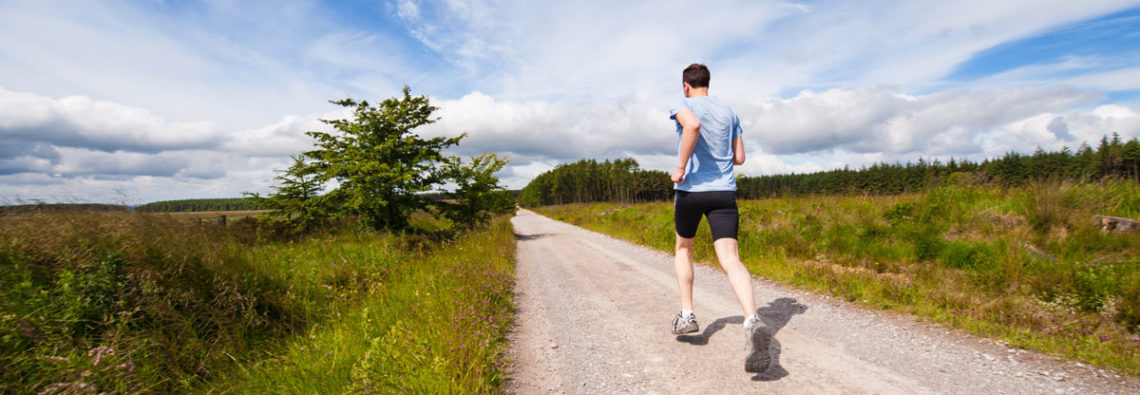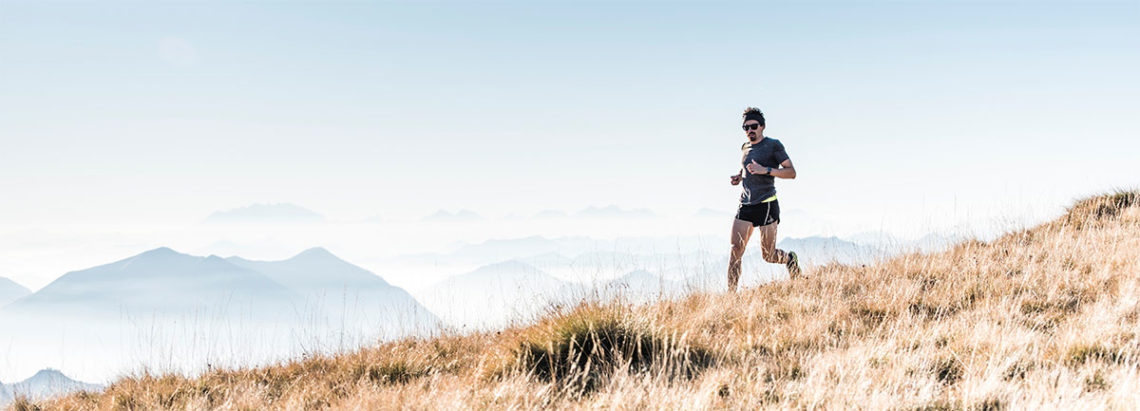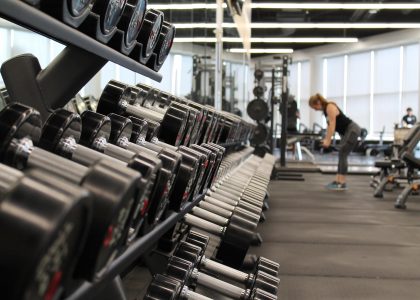Everyone is talking about cardio training.
It should melt the pounds, make you fit and also be fun?
Sounds, if you ask me, almost like an egg-laying woolly milk pig – with running shoes.
The cool thing: if you pay attention to a few points, cardio training actually becomes one.
You can find out which ones are in this article.
What this article includes:
Cardio training – the basics

In the first chapter you will learn the basics and backgrounds of cardio training.Before we can deal with a term, we should First of all, everyone is talking about the same thing.
So.
What do I mean by cardio training?
All forms of training that contribute to increasing your endurance performance – in the sense of fatigue resistance and regeneration ability. It is not the strength of your muscles, but the capacity of the cardiovascular system, the performance-limiting factor.
Cardio training could also be translated as heart training.
You can tell from the root of the word. Cardio comes from the Greek “Kardia” which means heart. That’s why there are cardiologists, cardiograms and much more that has to do with your heart. The word cardio training – with “C” instead of “K” can be used synonymously.
Now let’s look at the subject in practice in bodyweight training.
You can do strength training without equipment if you choose the resistance of the exercise so that you do not manage more than 15, in endurance training a maximum of 20, repetitions at a time.
If you find the exercise so easy that you can do more than 20 repetitions at a time, you are already in cardio training.
Feel free to try it out for yourself: You will feel the difference.
When doing strength training, your muscles tire first. You feel a burning sensation in your muscles and therefore have to stop the load because your muscles can no longer use enough energy to carry out the movement.
With cardio training it looks different.
The fatigue is not noticeable locally, but relates to the whole body, namely to the cardiovascular system. In addition, you will surely sweat more.
Of course, the whole thing increases when you practice a classic endurance sport such as running, swimming or cycling, or when you work out on the ergometer and cross trainer. Cardio training in its purest form, so to speak.

Cardio training in sports science
In sports science we differentiate between cardio training – there, by the way, we speak of endurance training – even further:
- local endurance (less than 15% of the skeletal muscles are active and the cardiovascular system does not limit performance) and general Perseverance
- aerobic and anaerobic endurance (according to the primary type of energy supply)
- dynamic and static endurance (based on how the skeletal muscles work)
Let’s take another look at this distinction using examples.
Local VS general endurance
If you now do push-ups and can do well more than 20 in a row, you are on the road with local endurance.
You train your general endurance in bodyweight training with compound exercises like the burpee or jumping jack.
All endurance sports also train general endurance.
Aerobic VS anaerobic endurance
The distinction between aerobic and anaerobic endurance is made according to the intensity of your training. The more intense and strenuous, the more likely you are to be in the anaerobic area. This means that you are taking on an oxygen debt that your body can compensate for a short time, but which soon signals to you that you should slow down.
If you want to know more about aerobic training, the best thing to do is read up on my blogger colleague Jahn: How aerobic training works and why it is so important.
You can also find a nice summary of the energy supply in the human body in the following video.
Static VS dynamic endurance
Static endurance can best be explained using the plank (forearm support): If you can stay in the plank for a few minutes, you are clearly training your static endurance.
Dynamic movements, on the other hand, also train dynamic endurance, of course.
What are the benefits of regular cardio training?
With at least 150 minutes a week at medium intensity or 75 minutes at higher intensity or a mixture of these, you can expect measurable health-promoting effects (see the Austrian recommendations for health-enhancing exercise).
These effects include:
Muscles
Cardiovascular system
Increasing the heartbeat volume with an accompanying lower heart rate (your heart can pump more blood through your body per beat)
Reduction of systolic blood pressure (brings your blood pressure to a healthy level of approx. 120/80 mmHg)
Reduction of peripheral vascular resistance (your blood vessels become more elastic and therefore more resistant)
Metabolism
Stimulation of metabolic processes (better exchange, removal of toxins, etc.)
medium-term increase in basal metabolic rate and fat burning (helps you look good naked)
Quite a lot, right?
Isn’t it worth it to turn your bastard into a tiger eagle?
I think so.
But let’s get into practice now: How can you implement cardio training? What options do you have?
My top 10 sports for cardio training

Once you’ve found a sport that you enjoy, cardio training becomes child’s play.
There are numerous ways in which you can exercise your cardiovascular system. I would like to bring you closer to my favorites here.
There is sure to be something for you too.
1. Running
My clear number one when it comes to exercising the cardiovascular system.
You hardly need any equipment, just good shoes and maybe even breathable clothing.
If you want to start running, you will find valuable tips here.
If you already run regularly, this article will definitely take you further: Running training for advanced runners.
2. Cycling
Also a classic when it comes to cardio training.
I especially love it in the hot summer months, when the airstream is so cool.
You can also explore your surroundings a lot better on the bike than when running. You can easily cover more kilometers and can therefore also reach places further away.
I mostly rely on the extensive continuous method on my bike tours. I’ll explain exactly what that is later.
3. Bodyweight Training
Yes, demanding cardio training is possible even with your own body weight.
I mostly rely on more intensive training methods, such as high-intensity interval training.
And I was also able to find out that it even improved my running endurance.
You can get tips on how to do this in my guest article “How to increase your endurance with bodyweight training” on the endurance blog from my blogger colleague Torsten.
4. Game sports
Cardio training is not so easy to control in game sports such as soccer, volleyball, handball, basketball and the like, but it is more fun to jog through the forest alone.
Most of the time, at least.
Unfortunately, the risk of injury with this type of cardio training is a little higher due to contact with the opponent.
But if you like to do it, what the heck: Go for it! Have fun playing with your friends.
You’re most likely to find me playing soccer or beach volleyball.
5. Hiking
I really enjoy doing it, but far too seldom.
Is that how you feel?
In any case, hiking is great for the body and mind, because we not only exert ourselves physically, but can also relax perfectly in nature.
The alpine region with its mountain panorama invites you to go on long hikes.
If you need a few additional tips for hiking, then read here: The right clothing for your next outdoor adventure.
6. Inline skating
You don’t need much more than a good pair of inline skates and protective equipment such as a helmet, knees, elbows and wrist protectors.
Then you can start.
Anyone who can ice skate has a clear advantage – because the movement is very similar.
Find a flat stretch with a good surface – fresh asphalt that has no cracks is best and get started.
If you are still unsure, it is best to start practicing after peak hours in an empty parking lot or something similar.
7. Ergometer
The bicycle ergometer is one of the most important pieces of equipment for top athletes in winter.
In contrast to a normal exercise bike, you can also precisely set the resistance – i.e. the watts – and thus do a proper workout.
When buying, make sure that you can continuously adjust the wattage and that your system has a flywheel that is as heavy as possible (ideally over 20 kg).
Then you’ll have fun with it too.
8. Cross trainer
The indoor alternative to the ergometer is the cross trainer.
The advantage of this is that you also use your arms a lot and thus increase your calorie consumption even further.
This is also important if you want to lose weight. Because then you need a calorie deficit.
But be careful: Your diet also plays a major role!
9. (Nordic) walking
No matter whether with or without sticks.
Simple walking outdoors in nature is not too strenuous cardio exercise for most of us, but it still offers some advantages.
In no other sport can you perceive nature in your surroundings as well as in walking (when hiking you are usually somewhere else anyway, e.g. on vacation). The simple reason for this is that you move more slowly and thus have more time to explore your surroundings.
If you want to add a little tension, try the following: Walk in one direction for 15 minutes. As fast as you can. It should feel like walking would be more comfortable, but you’re still walking.
After 15 minutes you turn around and try to be back at home after a maximum of 15 minutes – or maybe to do a few more meters.
10. Swimming
I have to be so honest: I swim almost as well as a “leaden duck”.
For me, swimming is almost always high-intensity interval training, at least when I want to do the crawl. Since I don’t do it often, my movements are technically not economical enough that after each length (ok, I would probably be able to crawl 2 lengths without going under) I need a break to catch my breath.
This year, however, I swam more often and for longer than ever before, so that’s definitely something that motivates me to stick with it so that I can crawl a few lengths soon.
How are your swimming skills?
11. 1st bonus tip – triathlon
The combination of the three most popular endurance sports – swimming, cycling and running – is the triathlon.
I’m definitely not an expert in this, but my blogger colleagues Lotta and Schorsch from tri-it-fit.de are.
They have summarized the most important things about triathlon for you in their guest post: Fascination Triathlon – 6 reasons that will also inspire you for this sport.
12. 2nd bonus tip – rowing
Shortly after the article was published, an attentive blog reader pointed out to me that she had had the best experience with rowing as cardio training.
It does not matter whether you are actually sitting in the boat and doing your meters on the river, lake or sea, or whether you buy a rowing machine for at home. You will also find such a rowing ergometer in every well-equipped gym.
You shouldn’t make the mistake of believing that you are only doing something for your arms when you are rowing. That is far from it.
The right rowing movement comes largely from the legs and back and is therefore a great whole body cardio workout.
So thanks Alex for the additional tip!
Interim conclusion
Once you’ve found the right sport for you, your cardio training will be a lot more fun.
You will have even more fun with a workout with these tips: 14 workouts that will make your workout more fun over the long term.







